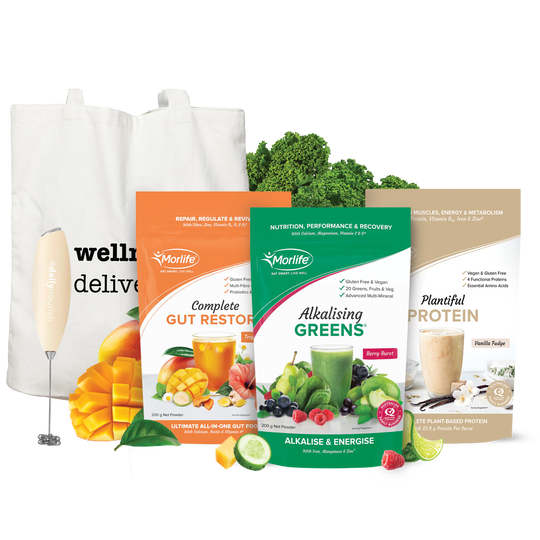‘All Fats Are Bad’ Is A Big Fat Lie - Here's Why

There has been so much hype and chit-chat around fats being harmful to your health over the years. This is absolutely not true - we’re here to set the record straight and explain the difference between the types of fats and help you feel empowered about making educated decisions!
To begin with, we’ve all heard that there are ‘good fats’ and ‘bad fats’, so let’s break this down. Good fats include monounsaturated and polyunsaturated fats, including essential fatty acids Omega-3 and Omega-6, and bad fats include trans-fats and most saturated fats.
Fats are a vital part of our diets. There is a reason omega-3 and omega-6 are considered essential, the body cannot produce them so they must be sourced from our diet. One simple reason to include fats in your diet is that many vitamins such as A, D, E and K are considered fat-soluble, meaning you need the fat in your diet in order to absorb them.
Monounsaturated fats have been found to increase the effectiveness of a cholesterol-lowering diet by increasing HDL cholesterol (good) and reducing LDL cholesterol (bad) levels which translates to a reduction in the risk of cardiovascular disease by over 20% (Jenkins et al. 2010). Many food sources of monounsaturated fats are also high in other beneficial nutrients such as Vitamin E (National Institutes of Health 2013) and antioxidants like flavonoids (Geleijnse & Hollman 2008) which further protect heart health.
Some great sources of monounsaturated fats to include in your diet are; avocados, olive oil, avocado oil, cod liver oil, macadamia nut oil, olives, almonds, cashews, macadamia nuts, pistachios, sesame seeds, sunflower seeds, flaxseeds and pumpkin seeds. Fish is also generally considered a source of polyunsaturated fatty acids like Omega-3, however, some fish like pickled herring, halibut, sablefish and mackerel are sources of monounsaturated fatty acids as well.
Omega-3 polyunsaturated fatty acids are essential fatty acids needed in the diet in order to help the body control blood clotting and build cell membranes in the body. Omega-3 can come in many forms, however, the most common are alpha-linolenic acid (ALA), eicosapentaenoic acid (EPA) and docosahexaenoic acid (DHA). ALA is particularly important as the body can generally use this form and convert it to other types of Omega-3 like EPA and DHA (Sacks 2014). Some great foods that are high in Omega-3s include flaxseeds and flaxseed oil, chia seeds, walnuts and fish - particularly salmon (fresh and tinned), mackerel, tinned sardines, tinned tuna & trout.
Omega-6 polyunsaturated fatty acids are another essential fatty acid needed in the diet. Similar to Omega-3’s, Omega-6’s are crucial for brain function and normal growth & development. Omega-6’s are also helpful in lowering LDL cholesterol levels, boosting HDL cholesterol and improving the body’s reaction to insulin and therefore keeping sugar levels under control (Harvard Heart Letter 2009). Omega-6 is often quite high in a western diet as it is found mostly in vegetable oils. Safflower oil, sunflower oil, corn oil, soybean oil, sunflower seeds, walnuts and pumpkin seeds are all good sources of Omega-6 fatty acids. It is however generally recognised that a greater intake of Omega-3 fatty acids is needed to help balance the existing high intake of Omega 6 (Harvard Heart Letter 2009), although if you are already consuming a healthy, balanced diet that is low in processed foods, it is likely that you are not overindulging in the Omega-6 containing oils.
We hope this helped to clear up some misconceptions around fats in the diet and hope this has proven to you how important fats are! If you have any questions, please don’t hesitate to reach out on our socials or send us an email!
References
Ehrlich, S 2011, Omega-6 fatty acids, University of Maryland Medical Center, viewed 4 June 2014, https://umm.edu/health/medical/altmed/supplement/...
Geleijnse, J & Hollman, P 2008, ‘Flavonoids and cardiovascular health: which compounds, what mechanisms?’,American Society of Clinical Nutrition, vol. 88, no. 1, pp. 12-13, viewed 3 June 2014,http://ajcn.nutrition.org/content/88/1/12.full
Harvard Heart Letter 2009, ‘No need to avoid healthy omega-6 fats’, Harvard Health Publications, viewed 4 June 2014, <www.ebscohost.com>
Jenkins, D, Chiavaroli, L, Wong, J, Kendall, C, Lewis, G, Vidgen, E, Connelly, P, Leiter, L. Josse, R & Lamarche, B 2010, ‘Adding monounsaturated fatty acids to a diet portfolio of cholesterol-lowering foods in hypercholesterolemia’,Canadian Medical Association Journal, vol. 182, no. 18, pp. 1961-1967, viewed 3 June 2014, <www.ebscohost.com>
Mensink R, Zock P, Kester A & Katan M 2003 ‘Effects of dietary fatty acids and carbohydrates on the ratio of serum total to HDL cholesterol and on serum lipids and apolipoproteins: a meta-analysis of 60 controlled trials’, American Journal of Clinical Nutrition, vol. 77, no. 5, pp. 1146-1155, viewed 3 June 2014,http://ajcn.nutrition.org/content/77/5/1146.long
National Institutes of Health 2013, Vitamin E – Fact Sheet for Health Professionals, viewed 3 June 2014,http://ods.od.nih.gov/factsheets/VitaminE-HealthProfessional/
Sacks, F 2014, Ask the Expert: Omega-3 Fatty Acids, Harvard School of Public Health, viewed 4 June 2014,http://www.hsph.harvard.edu/nutritionsource/omega-3/












